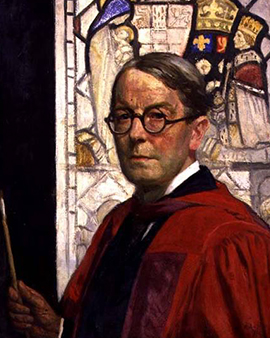As the son of a cheese merchant, Robert Robert Anning Bell was not exactly predestined to become an artist. He was born in London in 1862. It was probably his uncle, the architect Samuel Knight, who introduced him to art. He worked in his office at a young age and studied at the progressive University College School and the renowned Royal Academy. He shared his interest in new trends such as Symbolism and Art Nouveau with the sculptor George Frampton, with whom he also ran a studio. After he came into contact with the avant-garde of his time in Paris, he became an important representative of the Arts and Crafts movement in England.
One of his first highly regarded works was created in collaboration with Frampton: a high altar consisting of paintings and sculptures, which was exhibited at the Arts and Crafts Exhibition Society and is now in the Church of St. Clare in Liverpool. This work already reveals Bell's interest in medieval and Renaissance art. In cooperation with glass workshops, brightly coloured stained glass windows were created, which on the one hand refer to the old models, but on the other hand also combine modern elements. His works carry a secret within them, they exude a great magic and show the mastery and craftsmanship of a great artist and designer. At the height of his career, Robert Anning Bell was commissioned to execute the central mosaic for the tympanum of the main portal of Westminster Cathedral, based on sketches by the late master builder John Francis Bentley. This work is based on the mosaics of Byzantium, yet is very modern in its stylisation and composition. It was completed in 1916 and fits wonderfully into the overall composition of this neo-Byzantine church. In the 1920s he also created several mosaics for Westminster Palace.
Bell's paintings are atmospherically dense, enigmatic and radiate an extraordinary aesthetic. One might think, for example, of an Arcadian bathing scene with nymph-like beauties or of red-haired young women whom he portrayed very vividly, yet enraptured. When we look at his painting "Mary with Elisabeth", the great masters of the early Renaissance come to mind. He has undoubtedly orientated himself by them, without flatly imitating them. Book illustrations occupy a special place in his oeuvre. These include a wonderful gouache of a flight of elves, but also masterpieces in black and white in the manner of Art Nouveau. Consider, for example, the atmospheric illustrations to the dramas of William Shakespeare: King Lear, Hamlet or Romeo and Juliet. Robert Anning Bell portrayed himself in front of one of his colourful stained glass windows; he died in 1933. Seen from today, his works, most of which were created in the 20th century, seem to be out of time. But this is precisely what makes them so magical.
×





_-_(MeisterDrucke-1665822).jpg)
_-_(MeisterDrucke-1665822).jpg)
_-_(MeisterDrucke-1480980).jpg)
_-_(MeisterDrucke-1480980).jpg)
.jpg)
.jpg)
.jpg)
.jpg)
.jpg)
.jpg)
.jpg)
.jpg)
.jpg)
.jpg)
_-_(MeisterDrucke-1052855).jpg)
_-_(MeisterDrucke-1052855).jpg)
.jpg)
.jpg)
_-_(MeisterDrucke-1051251).jpg)
_-_(MeisterDrucke-1051251).jpg)
.jpg)
.jpg)
_-_(MeisterDrucke-1106960).jpg)
_-_(MeisterDrucke-1106960).jpg)
 - (MeisterDrucke-301310).jpg)
 - (MeisterDrucke-301310).jpg)
_-_(MeisterDrucke-1057330).jpg)
_-_(MeisterDrucke-1057330).jpg)
_-_(MeisterDrucke-1052602).jpg)
_-_(MeisterDrucke-1052602).jpg)
.jpg)
.jpg)
.jpg)
.jpg)
 - (MeisterDrucke-170482).jpg)
 - (MeisterDrucke-170482).jpg)
.jpg)
.jpg)
.jpg)
.jpg)
.jpg)
.jpg)
.jpg)
.jpg)
.jpg)
.jpg)
.jpg)
.jpg)
_-_(MeisterDrucke-1052858).jpg)
_-_(MeisterDrucke-1052858).jpg)
.jpg)
.jpg)
_-_(MeisterDrucke-1480981).jpg)
_-_(MeisterDrucke-1480981).jpg)
.jpg)
.jpg)
.jpg)
.jpg)
_-_(MeisterDrucke-1051254).jpg)
_-_(MeisterDrucke-1051254).jpg)
_-_(MeisterDrucke-1500355).jpg)
_-_(MeisterDrucke-1500355).jpg)
_-_(MeisterDrucke-1059529).jpg)
_-_(MeisterDrucke-1059529).jpg)
.jpg)
.jpg)
.jpg)
.jpg)
.jpg)
.jpg)
.jpg)
.jpg)
.jpg)
.jpg)
_-_(MeisterDrucke-1055273).jpg)
_-_(MeisterDrucke-1055273).jpg)
.jpg)
.jpg)
_-_(MeisterDrucke-1051252).jpg)
_-_(MeisterDrucke-1051252).jpg)
.jpg)
.jpg)
.jpg)
.jpg)
.jpg)
.jpg)
.jpg)
.jpg)
.jpg)
.jpg)
.jpg)
.jpg)
.jpg)
.jpg)
.jpg)
.jpg)
.jpg)
.jpg)
.jpg)
.jpg)
_-_(MeisterDrucke-1052597).jpg)
_-_(MeisterDrucke-1052597).jpg)
_-_(MeisterDrucke-1052577).jpg)
_-_(MeisterDrucke-1052577).jpg)
.jpg)
.jpg)
.jpg)
.jpg)
.jpg)
.jpg)
.jpg)
.jpg)
_-_(MeisterDrucke-1132629).jpg)
_-_(MeisterDrucke-1132629).jpg)
_-_(MeisterDrucke-1129155).jpg)
_-_(MeisterDrucke-1129155).jpg)
_-_(MeisterDrucke-1054681).jpg)
_-_(MeisterDrucke-1054681).jpg)
.jpg)
.jpg)
.jpg)
.jpg)
_-_(MeisterDrucke-1055274).jpg)
_-_(MeisterDrucke-1055274).jpg)
_-_(MeisterDrucke-1050802).jpg)
_-_(MeisterDrucke-1050802).jpg)
.jpg)
.jpg)
.jpg)
.jpg)
_-_(MeisterDrucke-1051256).jpg)
_-_(MeisterDrucke-1051256).jpg)
.jpg)
.jpg)
.jpg)
.jpg)
_-_(MeisterDrucke-1054662).jpg)
_-_(MeisterDrucke-1054662).jpg)
.jpg)
.jpg)
.jpg)
.jpg)
.jpg)
.jpg)
_-_(MeisterDrucke-1051486).jpg)
_-_(MeisterDrucke-1051486).jpg)
.jpg)
.jpg)
_-_(MeisterDrucke-1052578).jpg)
_-_(MeisterDrucke-1052578).jpg)
_-_(MeisterDrucke-1052490).jpg)
_-_(MeisterDrucke-1052490).jpg)
.jpg)
.jpg)
_-_(MeisterDrucke-1052587).jpg)
_-_(MeisterDrucke-1052587).jpg)
_-_(MeisterDrucke-1511030).jpg)
_-_(MeisterDrucke-1511030).jpg)
_-_(MeisterDrucke-1054682).jpg)
_-_(MeisterDrucke-1054682).jpg)
_-_(MeisterDrucke-1057333).jpg)
_-_(MeisterDrucke-1057333).jpg)
.jpg)
.jpg)
.jpg)
.jpg)
_-_(MeisterDrucke-1501059).jpg)
_-_(MeisterDrucke-1501059).jpg)
_-_(MeisterDrucke-1510840).jpg)
_-_(MeisterDrucke-1510840).jpg)
.jpg)
.jpg)
_-_(MeisterDrucke-1057335).jpg)
_-_(MeisterDrucke-1057335).jpg)
.jpg)
.jpg)
_-_(MeisterDrucke-1051484).jpg)
_-_(MeisterDrucke-1051484).jpg)
_-_(MeisterDrucke-1055272).jpg)
_-_(MeisterDrucke-1055272).jpg)
_-_(MeisterDrucke-1059547).jpg)
_-_(MeisterDrucke-1059547).jpg)
.jpg)
.jpg)
_-_(MeisterDrucke-1055277).jpg)
_-_(MeisterDrucke-1055277).jpg)
.jpg)
.jpg)
.jpg)
.jpg)
.jpg)
.jpg)
.jpg)
.jpg)
.jpg)
.jpg)
.jpg)
.jpg)
_-_(MeisterDrucke-1059550).jpg)
_-_(MeisterDrucke-1059550).jpg)






